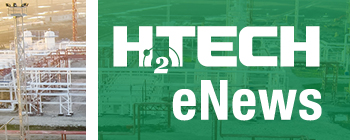News
Qair secures financing for Hyd’Occ renewable H2 ecosystem, advancing its green H2 strategy
Independent renewable energy company Qair announces the successful financing of its renewable H2 ecosystem in Occitanie, France. This landmark €55-MM financing, secured in partnership with Crédit Agricole and Bpifrance, will support the pending construction of the Hyd’Occ H2 production facility in Port-La Nouvelle, along with five refueling stations strategically located along major regional transport routes. Commissioning of the first production unit is expected by the end of the year.
This ecosystem represents a fully integrated solution for the production, transport and distribution of renewable H2, contributing to the decarbonization of road transport and the wider energy transition. The first 20-MW phase of the plant will produce 2,700 tpy of renewable H2, avoiding the emission of 27,000 tpy of CO₂. A second phase will double capacity to 40 MW, enabling production of 5,400 tpy.
Hyd’Occ will power a regional H2 mobility network, including the Narbonne and Béziers stations, both under construction and part of the “Corridor H2” initiative supported by the Occitanie Region, the European Investment Bank, and the European Union’s Connecting Europe Facility. This zero-emission corridor will connect the Iberian Peninsula with Northern Europe, advancing Europe’s ambition for sustainable heavy mobility.
Qair’s renewable H2 production facility is also backed by offtake agreements with major players such as Plug Power and local players such as Hydromer, securing more than 1,500 tpy of H2. First deliveries of renewable H2 are scheduled by the end of this year.
As France’s largest renewable H2 production facility, Hyd’Occ marks a decisive step for Qair in establishing H2 as an operational reality for local territories. Yet, this project is only one pillar of the group’s international strategy to become a leading independent producer of green H2 with large-scale facilities worldwide.
In Iceland, Qair is developing in three successive phases the Katanes project, an 840-MW green ammonia initiative in Grundartangi with 780-MW electrolyzer capacity. A green H2 distribution infrastructure is also being deployed across the country through the Blær project, under which Qair has already acquired two stations in Reykjavik—including the world’s first commercial station built in 2003—and will expand the network with four additional sites nationwide. Together, Katanes and Blær position Iceland as both a hub for large-scale renewable H2 and a pioneer in H2 mobility.
In Brazil, Qair is advancing large-scale H2 and ammonia projects at the Pecém Industrial Port. These initiatives aim to serve both domestic markets—through H2 for industrial use—and international demand, with significant volumes of ammonia destined for Europe. Drawing on Brazil’s exceptional renewable energy resources and Qair’s own solar and wind portfolio nearby, these projects are set to anchor the company within the global green H2 value chain.
In France, Qair is also preparing the Methavert project, an e-methanol production facility at the Haropa Port site in Le Havre. With a target capacity of 200,000 tpy of eMethanol, Methavert will leverage renewable H2 and locally available CO₂ to decarbonize hard-to-abate sectors such as shipping and chemicals, while taking advantage of existing storage and logistics infrastructure.
To complement its production projects and ensure the distribution of its green molecules, Qair has forged strategic partnerships with leading players across the value chain. By pairing industrial-scale production with robust distribution networks Qair is demonstrating its ability to design, finance, and implement complete renewable H2 ecosystems.

